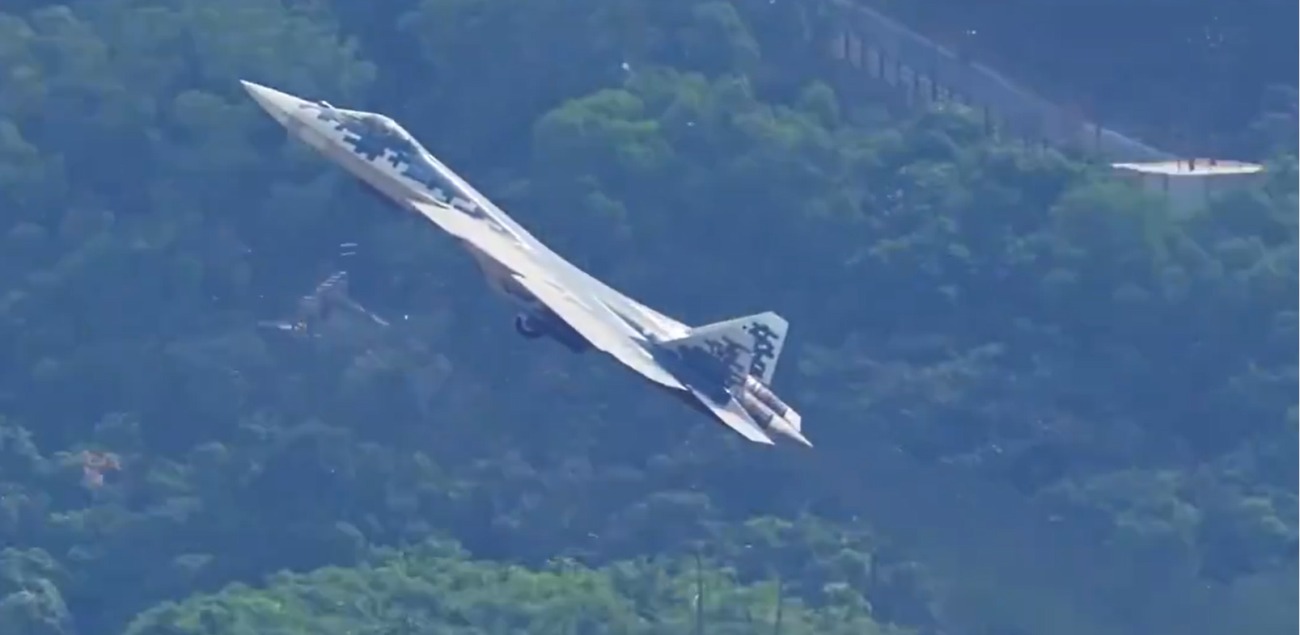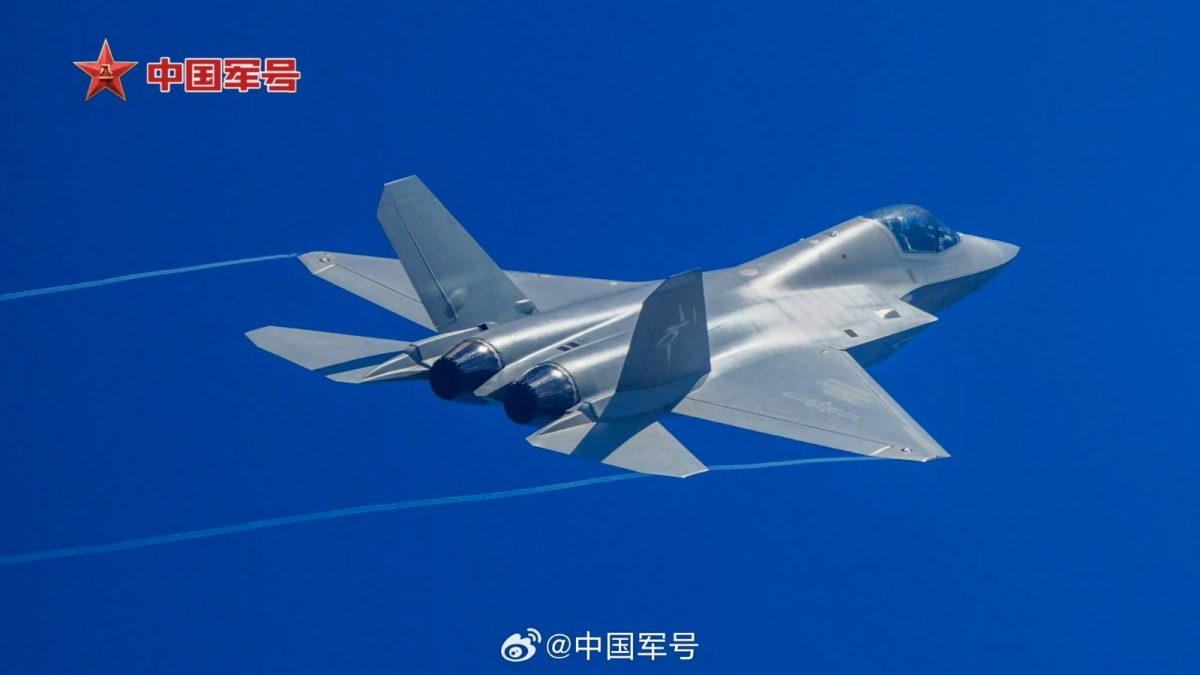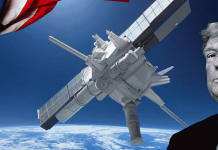Two 5th-generation fighter jets —the Russian Su-57 ‘Felon’ and Chinese J-35—are taking to the skies at the ongoing annual Zhuhai air show. The two aircraft are in the market for export, and the jury is still out on which one has the upper hand.
This is the first air show the Felon has attended in a foreign country, indicating the closeness of Russia’s and China’s ties.
Beijing has unveiled its second stealth fighter jet, the J-35, which is claimed to have been built using “stolen” American military technology. On November 12, the J-35 flew briefly at the China International Aviation & Aerospace Exhibition, taking to the smog-filled sky with its twin engines roaring.
The Su-57, Russia’s most advanced front-line aircraft, is produced at the Komsomolsk-on-Amur Aviation Plant in the Russian Far East.
Russia has been hopeful that its sophisticated Su-57 fighter jet, its answer to the US F-35 and Chinese J-20 Mighty Dragon, could prompt the Indian Air Force (IAF) to relook at the stealth fighter.
The Su-57 is Russia’s first new fighter jet since the end of the Cold War. Despite being in development for nearly two decades, it is unlikely to be produced in huge numbers soon, as the invasion of Ukraine puts a great strain on the Russian economy.
Meanwhile, China’s second radar-evading stealth jet after the J-20 is part of the endeavor to match the US’s air power built on the F-35 and F-22. The J-35 will also be used on China’s growing fleet of aircraft carriers—two are deployed, and a third is undergoing trials.
The J-35 is also being built with exports in mind. India’s neighbor Pakistan might be interested in what Western experts call a low-end stealth aircraft that includes technology used in the J-20.
The West has also looked down upon Su-57 ‘Felon.’ In Top Gun 2, Maverick (Tom Cruise) entered a dog fight against a Su-57 fighter jet. Not only did Maverick fight the two intercepting Su-57s in his stolen F-14 Tomcats, but he also annihilated the Russian 5th-generation fighter jets on the silver screen.
One of the major issues has been the limited production of Su-57s. It has been 14 years since its first flight in 2010, and less than 40 aircraft have been delivered. This is primarily due to design and development delays and the slow rate of production compounded by Western Sanctions. Actual production didn’t even begin until 2019, reflecting the industrial bottlenecks that have hampered Russia’s war effort.

Western experts have estimated the aircraft’s Radar Cross-Section (RCS) at around 0.5 square meters, which is about the same as a typical 4th-generation aircraft and certainly phenomenally more than the F-35 class fighters.
Can Felon Fly To Aerial Supremacy?
Chinese aviation enthusiasts have criticized Felon’s first appearance at the Zhuhai International Air Show. The aircraft’s fuselage panels, which are attached to the frame with numerous bolts (some of which protrude above the surface), the tail section, which is attached with a mishmash of bolts and screws (including Philips screws, cross head screws, straight head screws, and hexagonal screws), and the wings and doors of the internal weapons compartment are all poorly fitted, according to Chinese social media users.
The first Su-57 crashed in eastern Russia in 2019 while executing a fight test. This was the first total loss of a Su-57, although one of the type’s T-50 prototypes was severely damaged due to an engine fire in 2014.
The accident delayed the aircraft’s entry into the Russian Aerospace Force Service. Hence, when Russia invaded Ukraine in 2022, its aircraft deployment included Sukhoi Su-30SM and Su-35 fighters, Su-34 strike aircraft, and Su-25 close air support jets, but not any of the Su-57s.
Flight International’s 2022 World Air Forces lists just one Su-57 in service with the Russian Aerospace Forces. The Russian State news agency TASS had earlier reported that the Russian air force would receive 22 aircraft by the end of 2024, bumping this figure to 76 by 2027-28. The Ukraine war, however, has thrown a spanner in the Kremlin’s fighter jet production plan.
So far, Russia has not been able to fit the new stealth-optimized Saturn AL-51 engine into the Su-57. The Felons are still flying using Russia’s old Saturn AL-41F1 after-burning turbofan engine.
The Sukhoi Su-57 is designed to destroy air, ground, and naval targets. It has increased stealth due to the broad use of composite materials and can reach a supersonic cruising speed. It is said to be equipped with the most advanced onboard radio-electronic equipment, including a powerful onboard computer (the so-called electronic second pilot). Its radar system is spread across its body, and its armament is placed inside its fuselage.
The Su-57 AI system assumes some of the pilot’s functions, including piloting and preparing for weapon use.
Regarding arms, the Su-57 will be armed with beyond-visual-range missiles and two short-range missiles for air-to-air combat missions. The fighter’s primary medium-range missile is the active radar-homing K-77M (Izdeliye 180).
An upgraded version of the R-77 medium-range missile, the K-77M is a beyond-visual-range (BVR) radar-guided missile equipped with an active electronically scanned array radar seeker. Russia also plans to add the new R-37M long-range hypersonic missiles to the aircraft’s firepower.
For ground strike capability, the Su-57 is fitted with the Kh-38 tactical air-to-ground missile and a range of KAB family precision-guided bombs. It can also carry anti-radiation missiles for targeting ground-based radars, electro-optical guided bombs, and anti-ship missiles. If stealth is not a concern, the aircraft can carry weapons externally on its wings and fuselage.
The Su-57 is a flatter, more angular airframe than earlier jets, with a blended wing and body configuration to give it built-in stealth.
Russia is also looking to field the S-70 Okhotnik (Hunter-B) strike drone alongside the Su-57 as a ‘loyal wingman’ to the stealth fighter jet. UAC CEO Yury Slyusar said earlier that the Su-57 fifth-generation jet was a step toward the sixth-generation aircraft and will be used to develop the family.
There have been reports about Russia working on using an unpiloted mode in Su-57 during tests. The Su-57 platform is continuously evolving, as indicated by ongoing flight tests that involve the integration of a second-stage engine, as disclosed by the state corporation overseeing the program.

The Splashy Debut Of J-35
As expected, China’s second stealth aircraft, the J-35, became the star attraction at the Zhuhai Air Show. Manufactured by the Shenyang Aircraft Corporation, the aircraft is described as a “medium-sized stealth multi-purpose fighter.”
Little information is available about the aircraft’s performance or capabilities; however, many point out its uncanny resemblance to Lockheed Martin’s F-35.
A follow-on program on its J-31 fighter, the J-35 seeks to expand the jet’s range and payload to project power beyond China’s maritime borders. The development of J-35 is driven by opportunities in the export market. The transition from the J-31 to the J-35 variant has additional modifications to the aircraft.
The J-35 features a cockpit layout and canopy modeled after the F-35B, providing improved visibility for the pilot. Its reinforced landing gear and foldable outer-wing panels optimize performance on carrier decks, while its advanced active electronically scanned array (AESA) radar enables superior situational awareness.




